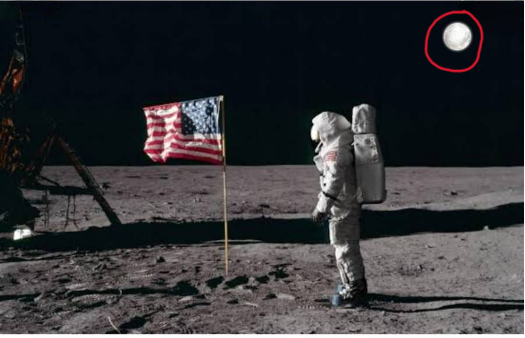In today’s social media age, viral puzzles and optical illusions are everywhere, challenging our observational skills and logical reasoning. One such image has sparked widespread curiosity: a seemingly ordinary depiction of an astronaut standing on the moon with a flag in the background. The question is simple yet puzzling: Can you spot what’s wrong with this picture?
At first glance, the image looks like a standard moon landing photo. But upon closer inspection, something is glaringly off. Ready to find out what it is? Let’s break it down step by step and uncover the mystery.

Why This Image Catches People Off Guard
The allure of this puzzle lies in its subtlety. It presents a familiar scene, relying on your brain to recognize patterns and accept what looks “normal.” But here’s the catch: our brains often overlook inconsistencies when we focus on the bigger picture.
What makes puzzles like these challenging is the interplay between detail and context. When you think you’re analyzing everything, your mind is tricked into ignoring what doesn’t align with your expectations. That’s what makes this viral image so brilliant—it’s simple, but it catches even the sharpest observers off guard.
Step-by-Step Breakdown of the Image
Let’s analyze the image methodically to identify what’s wrong. Follow along closely to see if you can spot the anomaly yourself.
1. Examine the Astronaut
The astronaut appears to be dressed in a classic space suit, complete with a helmet, oxygen tank, and gloves. Everything looks in place, consistent with historical moon landing photos.
- Conclusion: No errors here; the astronaut is as expected.
2. Study the American Flag
The American flag is a prominent feature in the image. It appears to be slightly “waving,” which might raise eyebrows since the moon has no atmosphere. However, this detail aligns with historical photos, where a horizontal rod held the flag’s shape.
- Conclusion: The flag’s appearance isn’t the issue.
3. Analyze the Lunar Surface
The ground is depicted as a dusty, gray expanse with craters—a standard portrayal of the moon’s surface. There’s nothing unusual about the texture or features of the environment.
- Conclusion: The lunar surface looks accurate.
4. Shift Your Focus to the Sky
This is where the puzzle’s hidden inconsistency emerges. Look closely at the top right corner of the image. What do you see?
- A bright, round object—a second moon!
Wait a second. How can there be another moon visible in the sky if the astronaut is already standing on the lunar surface? This is the glaring error that many people overlook on their first pass. The presence of a second moon defies physics, logic, and everything we know about space.
The Big Reveal: A Second Moon
The answer to the puzzle lies in the presence of this impossible second moon. It’s a subtle but deliberate error designed to test your observational skills and ability to question what you see. Most viewers miss it initially because they assume the image accurately represents the moon landing.

Why Do We Miss Obvious Details?
Our brains are wired to rely on patterns and assumptions, which makes puzzles like these so effective. Here’s why you might have missed the second moon:
- Familiarity Bias: The image resembles the iconic moon landing photos we’ve all seen before. This familiarity causes us to accept the scene as accurate without questioning the details.
- Focus on Details: Viewers often get caught up analyzing the astronaut, the flag, or the surface, ignoring the broader context.
- Overthinking: Some people dive too deep, looking for complex scientific errors or hidden symbols, while the actual issue is deceptively simple.
What Makes This Puzzle So Engaging?
Puzzles like this aren’t just entertaining—they’re also a great way to sharpen your mind. Here’s why they resonate with so many people:
- They Challenge Perception: These puzzles force us to slow down and look at things differently, encouraging us to question our assumptions.
- They’re Social: Sharing your answer and seeing how others interpret the image fosters fun and friendly competition.
- They Enhance Observational Skills: By training your brain to spot inconsistencies, you develop sharper attention to detail—a skill that’s useful in everyday life.
How Did You Do?
Did you spot the second moon right away, or did it take a few tries? Whether you cracked the puzzle instantly or needed some guidance, the challenge itself is what makes it worthwhile. Don’t be discouraged if you missed it—these puzzles are designed to be tricky!
If you enjoyed solving this puzzle, why not share it with your friends and family? See who can identify the mistake the fastest and enjoy a few laughs along the way.
The Joy of Puzzles: Keep Challenging Yourself
This viral image is a reminder of how much fun it can be to think critically and observe carefully. Optical illusions, riddles, and brain teasers offer more than just entertainment—they help improve your cognitive skills, foster creativity, and encourage outside-the-box thinking.
So, the next time you come across a puzzling photo, take a moment to pause, analyze, and question what you see. Who knows? You might discover a hidden detail that everyone else missed.
Conclusion
The “What’s wrong with this photo?” puzzle is a clever test of observation and logic, proving that even the simplest questions can stump us. The second moon is a reminder that our assumptions can blind us to glaring errors.
Take this as an opportunity to sharpen your focus, question the obvious, and enjoy the thrill of solving challenges. After all, the joy of discovery is what makes puzzles like these so rewarding. Ready for the next brain teaser? Dive in and see how sharp your skills really are!